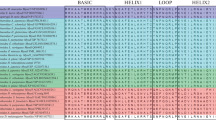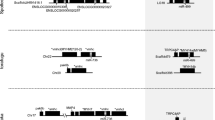Abstract
Vertebrate MyoD family of transcription factors contains four members including MyoD, Myf5, Myogenin and MRF4. These myogenic regulatory factors (MRFs) play key roles in regulating skeletal muscle development and growth. Evolutionary analysis suggests that the four vertebrate MRF genes were derived by gene duplications from a single ancestral gene during chordate evolution. Better understanding of the structure and regulation of MyoD expression in amphioxus Branchiostoma belcheri may provide insight into the evolutionary history of myogenic gene duplications because of the unique position of amphioxus in evolution. We report here that isolation and characterization of a new MyoD gene, AmphiMyoD, in B. belcheri. Sequence analysis revealed that the AmphiMyoD is more closely related to myogenic transcription factors in invertebrates and vertebrates compared with the previously identified three MyoD like genes in amphioxus, suggesting that the AmphiMyoD might be the closest relative of the ancestral myogenic gene. To determine if the AmphiMyoD gene promoter controls muscle-specific expression, the AmphiMyoD promoter was linked with the green fluorescence protein (GFP) reporter and the construct was microinjected into zebrafish embryos for transient expression assay. AmphiMyoD promoter directed skeletal muscle-specific GFP expression in zebrafish embryos. In addition, it also drove GFP expression in cardiac muscles of the injected embryos, but not in other non-muscle tissues. These data demonstrated that the AmphiMyoD promoter contained regulatory elements for skeletal and cardiac muscle-specific expression. Moreover, the regulatory element(s) could function across species.
Similar content being viewed by others
Abbreviations
- bHLH:
-
basic helix-loop-helix domain
- GFP:
-
green fluorescent protein
- hpf:
-
hours post fertilization
- MRF:
-
myogenic regulatory factor
- PBS:
-
phosphate buffered saline
- PBST:
-
0.1% Tween-20 in 1×PBS
- RACE:
-
rapid amplification of cDNA ends
- UTR:
-
untranslated region
References
Araki I., Saiga H., Makabe K.W. & Satoh N. 1994. Expression of AMD1, a gene for a MyoD1-related factor in the ascidian Halocynthia roretzi. Roux’s. Arch. Dev. Biol. 203: 320–327.
Araki I., Terazawa K. & Satoh N. 1996. Duplication of an amphioxus myogenic bHLH gene is independent of vertebrate myogenic bHLH gene duplication. Gene 171: 231–236.
Atchley W.R., Fitch W.M. & Bronner-Fraser M. 1994. Molecular evolution of the MyoD family of transcription factors. Proc. Natl. Acad. Sci. USA 91: 11522–11526.
Beach R.L., Seo P. & Venuti J.M. 1999. Expression of the sea urchin MyoD homologue, SUM1, is not restricted to the myogenic lineage during embryogenesis. Mech. Dev. 86: 209–212.
Blackwell T. K. & Weintraub H. 1990. Differences and similarities in DNA-binding preference of MyoD and E2A protein complexes revealed by binding site selection. Science 250: 1104–1110.
Braun T., Bober E., Rudnicki M.A., Jaenisch R. & Arnold H.H. 1994. MyoD expression marks the onset of skeletal myogenesis in homouzygous Myf5 mutant mice. Development 120: 3083–3092.
Braun T., Rudnicki M.A., Arnold H.H. & Jaenisch R. 1992. Targeted inactivation of the mouse regulatory gene Myf5 results in abnormal distal rib development and early postnatal death in homozygous mouse mutants. Cell 71: 369–382.
Chen Y.H., Lee W.C., Liu C.F. & Tsai H.J. 2001. Molecular structure, dynamic expression, and promoter analysis of zebrafish (Danio rerio) myf-5 gene. Genesis 29: 22–35.
Du S.J. & Dienhart M. 2001. The zebrafish tiggy-winkle hedgehog promoter directs notochord and floor plate GFP expression in transgenic zebrafish embryos. Dev. Dyn. 222: 655–666.
Du S.J., Gao J. & Anyangwe V. 2003. Muscle-specific expression of myogenin in zebrafish embryos is controlled by multiple regulatory elements in the promoter. Comp. Biochem. Physiol. B Biochem. Mol. Biol.134: 123–134.
Ettensohn C.A. & Ingersoll E.P. 1992. Morphogenesis of the sea urchin, pp. 210–230. In: Rossamundo E.F. & Alexander S. (eds), Morphogenesis: an Analysis of the Development of Biological Form. Marcel Dekker, New York.
Garcia-Fernandez J. & Holland P.W. 1994. Archetypal organization of the amphioxus Hox gene cluster. Nature 370: 563–566.
Hasty P., Braddley A., Morris J.H., Edmondson D.G., Venuti J.M., Olson E.N. & Klein W.H. 1993. Muscle deficiency and neonatal death in mice with targeted mutation in the myogenin gene. Nature 364: 501–506.
Holland P.W. 1999. Gene duplication: past, present and future. Semin. Cell Dev. Biol. 10: 541–547.
Karabinos A. & Bhattacharya D. 2000. Molecular evolution of calmodulin and calmodulin-like genes in the cephalochordate Branchiostoma. J. Mol. Evol. 51: 141–148.
Kimmel C.B., Ballard W.W., Kimmel S.R., Ullmann B. & Schilling T.F. 1995. Stages of embryonic development of the zebrafish. Dev. Dyn. 203: 253–310.
Krause M., Fire A., Harrison S.W., Priess J. & Weintraub H. 1990. CeMyoD accumulation defines the body wall muscle cell fate during C. elegans embryogenesis. Cell 63: 907–919.
Kusakabe R., Kusakabe T., Satoh N., Holland N.D. & Holland L.Z. 1997. Differential gene expression and intracellular mRNA localization of amphioxus actin isoforms throughout development: implications for conserved mechanisms of chordate development. Dev. Genes Evol. 207: 203–215.
Meedel T.H., Farmer S.C. & Lee J.J. 1997. The single MyoD family gene of Ciona intestinalis encodes two differentially expressed proteins: implications for the evolution of chordate muscle gene regulation. Development 124: 1711–1721.
Megeney L.A. & Rudnicki M.A. 1995. Determination versus differentiation and the MyoD family of transfactors. Biochem. Cell Biol. 73: 723–732.
Meyer A. & Schartl M. 1999. Gene and genome duplications in vertebrates: the one-to-four (-to-eight in fish) rule and the evolution of novel gene functions. Curr. Opin. Cell Biol. 11: 699–704.
Michelson A.M., Abmayr S.M., Bate M., Arias A.M. & Maniatis T. 1990. Expression of a MyoD family member prefigures muscle pattern in Drosophila embryos. Genes Dev. 4: 2086–2097.
Minguillon C., Ferrier D.E., Cebrian C. & Garcia-Fernandez J. 2002. Gene duplications in the prototypical cephalochordate amphioxus. Gene 287: 121–128.
Muller P., Seipel K., Yanze N., Reber-Müller S., Streitwolf-Engel R., Stierwald M., Spring J. & Schmid V. 2003. Evolutionary aspects of developmentally regulated helix-loop-helix transcription factors in striated muscle of jellyfish. Dev. Biol. 255: 216–229.
Murre C., McCaw P. S. & Baltimore D. 1989. A new DNA binding and dimerization motif in immunoglobulin echancer binding, daughterless, MyoD and myc proteins. Cell 56: 777–783.
Nabeshima Y., Hanaoka K., Hayasaka M., Esumi E., Li S., Nonaka I. & Nabeshima Y. 1993. Myogenin gene disruption results in perinatal lethality because of severs muscle defect. Nature 364: 532–535.
Nohara M., Nishida M., Yamaguchi T., Tomiyama M., Zhang P., Yokoyama H., Manthacitra V. & Nishikawa T. 2001. Mitochondrial DNA variation and genetic relationships of Branchiostoma species from Pacific and Atlantic Oceans. Zool. Sci. 18: 453–454.
Ohno S. 1970. Evolution by Gene Duplication. Springer-Verlag, Heidelberg.
Ono-Koyanagi K., Suga H., Katoh K. & Miyata T. 2000. Protein tyrosine phosphatases from amphioxus, hagfish, and ray: divergence of tissue-specific isoform genes in the early evolution of vertebrates. J. Mol. Evol. 50: 302–311.
Rudnicki M.A., Braun T., Hinuma S. & Jaenisch R. 1992. Inactivation of MyoD in mice leads to upregulation of the myogenic HLH gene Myf5 and results in apparently normal muscle development. Cell 71: 383–390.
Rudinicki M.A. & Janeisch R. 1995.The MyoD family of transcription factors and skeletal myogenesis. BioEssays 17: 203–209.
Rudnicki M.A., Schnegelsberg P.N., Stead R.H., Braun T., Arnold H.H. & Jaenisch R. 1993. MyoD or Myf-5 is required for the formation of skeletal muscle. Cell 75: 1351–1359.
Schubert M., Meulemans D., Bronner-Fraser M., Holland L.Z. & Holland N.D. 2003. Differential mesodermal expression of two amphioxus MyoD family members (AmphiMRF1 and AmphiMRF2). Gene Expr. Patterns 3: 199–202.
Shimeld S. M. 1997. Characterization of amphioxus HNF-3 genes: conserved expression in the notochord and floor plate. Dev. Biol. 183: 74–85.
Suga H., Hoshiyama D., Kuraku S., Katoh K., Kubokawa K. & Miyata T. 1999. Protein tyrosine kinase cDNAs from amphioxus, hagfish, and lamprey: isoform duplications around the divergence of cyclostomes and gnathostomes. J. Mol. Evol. 49: 601–608.
Sutherland D., McClellan J. S., Milner D., Soong W., Axon N., Sanders M., Hester A., Kao Y.H., Poczatek T., Routt S. & Pezzementi L. 1997. Two cholinesterase activities and genes are present in amphioxus. J. Exp. Zool. 277: 213–229.
Tan X. & Du S.J. 2002. Differential expression of two Myod genes in fast and slow muscles of gilthead seabream (Sparus aurata). Dev. Genes Evol. 212: 207–217.
Venuti J.M., Goldberg L., Chakraborty T., Olson E.N. & Klein W.H. 1991. A myogenic factor from sea urchin embryos capable of programming muscle differentiation in mammalian cells. Proc. Natl. Acad. Sci. USA 88: 6219–6223.
Venuti J., Morris J.H., Vivian J.L., Olson E.N. & Klein W.H. 1995. Myogenin is required for late but not early aspects of myogenesis during mouse development. J. Cell Biol. 128: 563–576.
Wang Y., Schnegelsberg P.N., Dausman J. & Jaenisch R. 1996. Functional redundancy of the muscle-specific transcription factors Myf5 and myogenin. Nature 379: 823–825.
Westerfiled M. 1995. The Zebrafish Book. Eugene, University of Oregon Press
Westerfield M., Wegner J., Jegalian B.G., DeRobertis E.M. & Püschel A.W. 1992. Specific activation of mammalian Hox promoters in mosaic transgenic zebrafish. Genes Dev. 6: 591–598.
Yuan J., Zhang S., Liu Z., Luan Z. & Hu G. 2003. Cloning and phylogenetic analysis of an amphioxus myogenic bHLH gene AmphiMDF. Biochem. Biophys. Res. Commun. 301: 960–967.
Author information
Authors and Affiliations
Corresponding authors
Rights and permissions
About this article
Cite this article
Tan, X., Zhang, P.J. & Du, S.J. Evolutionary aspects of a new MyoD gene in amphioxus (Branchiostoma belcheri) and its promoter specificity in skeletal and cardiac muscles. Biologia 69, 1210–1221 (2014). https://doi.org/10.2478/s11756-014-0427-z
Received:
Accepted:
Published:
Issue Date:
DOI: https://doi.org/10.2478/s11756-014-0427-z




